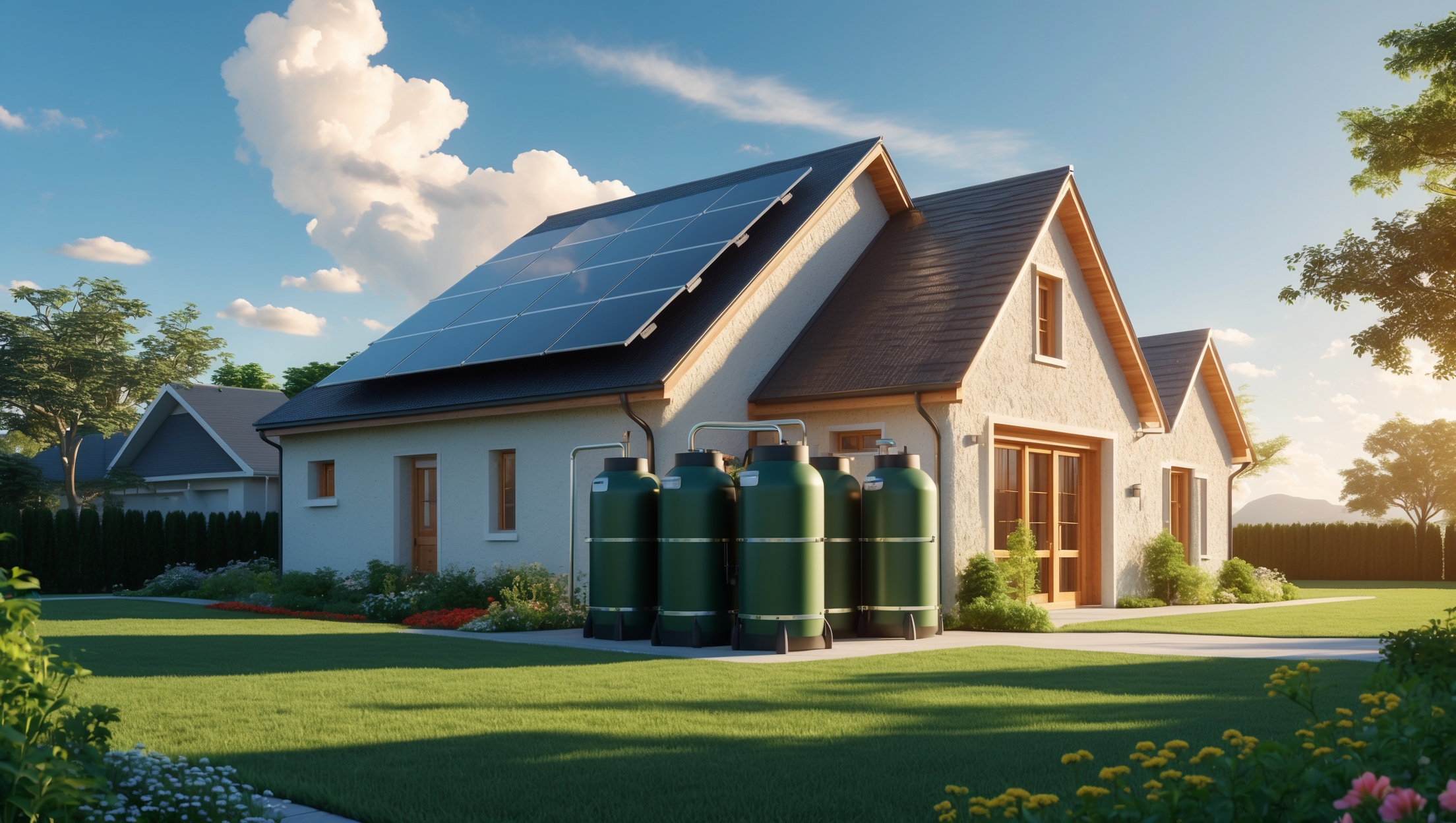Introduction: The Overlooked Power of Rainwater Harvesting Energy Systems
As the world pivots towards sustainable living and renewable energy solutions, the integration of rainwater harvesting with residential energy systems is gaining momentum. Many homeowners are now looking beyond traditional solar and wind, exploring water’s role not just for irrigation or gray water, but as a source for micro-hydro power or for improving the efficiency of heat pumps and solar thermal systems. Yet, the journey from inspiration to installation comes with a maze of rules, permits, and compliance requirements that can confuse and frustrate even the most passionate eco-enthusiast.
Understanding how to legally and safely install a residential rainwater harvesting system that supports your home’s renewable energy ambitions is crucial. Not only do you need to comply with local water rights, building codes, and utility interconnection standards, but you must also ensure your system does not inadvertently cause environmental or legal harm. This comprehensive guide will walk you through the practical steps for obtaining permits and ensuring compliance when installing a rainwater harvesting system designed to work in tandem with renewable energy technologies at home. Whether you’re looking to power a micro-hydro generator, boost your solar thermal efficiency, or simply store water for sustainable landscaping, you’ll find actionable advice and up-to-date regulatory insights here.
Understanding Residential Rainwater Harvesting Energy Systems
What Are Rainwater Harvesting Energy Systems?
Rainwater harvesting energy systems collect, store, and utilize rainwater for a variety of sustainable applications. When paired with renewable energy, harvested rainwater can:
- Power micro-hydro generators for electricity (if there is sufficient head and flow).
- Improve the efficiency of solar thermal systems by pre-heating or cooling water.
- Supply heat pump loops for geothermal or air-to-water systems.
- Reduce dependency on municipal water, lessening environmental impact.
Such integration requires careful design and, more importantly, strict adherence to local laws and building codes.
Why Compliance and Permits Matter
Installing a rainwater harvesting system that interacts with energy infrastructure is not as simple as placing barrels under gutters. Improper setups can contaminate municipal supplies, cause flooding, or violate water rights. Failing to secure the right permits or conform to standards can lead to fines, forced removal, or legal liability. Compliance ensures your system operates safely, efficiently, and legally.
Step 1: Research Local and State Regulations
Start with Your Municipality
Begin by contacting your local building or environmental health department. Ask about:
- Permitted uses for harvested rainwater (irrigation only, potable, energy systems, etc.).
- Maximum storage capacities.
- Setback requirements for tanks and underground cisterns.
- Rules for connecting harvested water to household plumbing.
- Water rights and restrictions (critical in states like Colorado or Utah).
State-Level Guidelines
Some states actively encourage rainwater harvesting with incentives, while others impose strict controls. Important points to check:
- State plumbing code amendments for rainwater systems.
- Requirements for potable vs. non-potable water use.
- Permitting for energy integration (e.g., micro-hydro permits from the state water board).
Check the Department of Environmental Quality or Water Resources website for your state for official documents.
Step 2: Determine Your System’s Classification
Is Your System Simple or Complex?
Permitting requirements often depend on system size and complexity:
- Simple Systems: Roof collection, above-ground barrels, no plumbing integration, used for irrigation—usually require minimal permitting.
- Complex Systems: Underground cisterns, pressurized plumbing, micro-hydro turbines, or integration with home water supply—require full permits and professional design.
Energy Component Considerations
If your system involves generating electricity or interfacing with existing energy infrastructure (e.g., solar thermal loop, heat pumps), you’ll likely need:
- Electrical permits for wiring and grid interconnection.
- Plumbing permits for water supply integration.
- Environmental review if altering stormwater runoff or impacting local waterways.
Step 3: Develop a Detailed System Plan
Essential Elements for Permit Applications
To secure permits, you’ll need to provide authorities with:
- Detailed site plan: Location of tanks, piping, energy components, and setbacks from structures/property lines.
- System diagram: Flow of rainwater from capture through storage to usage or energy generation.
- Component specifications: Make/model of pumps, filters, turbines, and electrical components.
- Backflow prevention measures: Protection against contamination of potable water supplies.
- Overflow and drainage solutions: To prevent localized flooding or erosion.
Professional drawings are often required for complex systems.
Step 4: Apply for Necessary Permits
Typical Permits Required
- Building Permit: For structural modifications, tank installation, or underground cisterns.
- Plumbing Permit: For any connection to existing plumbing, especially if water will be used inside the home.
- Electrical Permit: If installing pumps, controllers, or micro-hydro generators that connect to the grid.
- Environmental Permit: If system impacts stormwater drainage, wetlands, or public waterways.
- Water Rights Permit: In states where all rainwater is considered public resource, you may need explicit rights to collect and use it.
Permit Application Process
While the process varies by locality, most jurisdictions follow these steps:
- Submit detailed plans and applications to the relevant departments.
- Pay application fees.
- Allow for plan review (usually 2–6 weeks).
- Respond to requests for clarification or revisions.
- Receive permit approval before beginning installation.
Keep all correspondence and permits on file for inspections and future reference.
Step 5: Ensure System Compliance During Installation
Contractor Selection and Licensing
If your system is complex, hire licensed professionals:
- Certified plumbers for potable or pressurized systems.
- Licensed electricians for energy components.
- Rainwater system specialists accredited by organizations like ARCSA (American Rainwater Catchment Systems Association).
Provide contractors with copies of all permits and plans.
Inspections and Documentation
Local authorities will typically require:
- Mid-project inspections (e.g., before backfilling cisterns or connecting to mains).
- Final inspection after system completion.
- Testing of backflow prevention and overflow mechanisms.
- Electrical and plumbing code compliance checks.
Pass all inspections before operating your system. Failure to do so can result in hefty fines or forced deconstruction.
Step 6: Special Considerations for Energy Integration
Micro-Hydro Generation
Using harvested rainwater to generate electricity with a micro-hydro turbine introduces additional compliance issues:
- Water Rights: Some states treat hydro generation as a separate water use, requiring special permits.
- Electrical Interconnection: If you plan to feed power into the grid, utility permission and inspection is mandatory.
- Safety Standards: Turbine installations must meet national and local electrical codes (NEC, UL listings).
Solar Thermal and Heat Pump Integration
Rainwater can be used for pre-heating/cooling in solar thermal or heat pump loops, but:
- Closed-loop systems are preferred to prevent cross-contamination.
- Plumbing codes may require double-wall heat exchangers and backflow devices.
- Additional permits may be needed if modifying existing HVAC or plumbing systems.
Common Permit Pitfalls and How to Avoid Them
- Assuming small systems don’t need permits: Even simple barrel systems may require approval in water-restricted states.
- Neglecting backflow prevention: This is a frequent cause of failed inspections.
- Starting work before permits are issued: This can result in stop-work orders or fines.
- Not coordinating with utility providers: Especially critical if your system includes electricity generation or affects municipal water.
- Overlooking HOA restrictions: Homeowners’ associations may have their own rules about visible tanks or rooftop modifications.
Best Practices for Ongoing Compliance
Regular Inspections and Maintenance Logs
Some jurisdictions require periodic inspections or recertification for rainwater systems, especially those integrated with energy infrastructure. Keep detailed maintenance records and schedule annual checkups for:
- Tank integrity and water quality.
- Filter and pump operation.
- Backflow prevention device testing.
- Electrical system safety (for micro-hydro or pump-driven systems).
Stay Informed About Regulation Changes
Water and energy regulations are evolving rapidly as sustainable technologies proliferate. Subscribe to updates from local building departments, state water authorities, and relevant industry organizations to remain compliant and take advantage of new incentives or streamlined permitting processes.
Conclusion: Turning Compliance into a Sustainable Home Asset
Integrating rainwater harvesting with residential energy systems is a powerful step toward sustainability, resilience, and energy independence. While the permitting and compliance process can seem daunting, it exists to protect public health, ensure environmental stewardship, and prevent costly mistakes. By approaching the process methodically—researching local and state requirements, classifying your system accurately, developing comprehensive plans, applying for all necessary permits, and working with licensed professionals—you can avoid legal pitfalls and ensure your investment stands the test of time.
Remember, each jurisdiction has unique rules, and staying proactive is key. If in doubt, consult with local officials or a qualified environmental engineer. Compliance not only shields you from legal troubles but can also increase your home’s value, qualify you for rebates, and grant you peace of mind. As homeowners and communities increasingly embrace water-wise, energy-smart living, those who master the compliance landscape today will lead the way toward a greener, more self-sufficient future. With the right preparation and a commitment to best practices, your rainwater harvesting energy system can become a model of sustainable innovation for years to come.





If my main goal is to improve solar thermal efficiency by integrating harvested rainwater, is there a typical budget range I should expect for navigating the necessary compliance checks and permit applications, beyond just the equipment costs?
When integrating rainwater harvesting with a solar thermal system, compliance and permit costs can vary widely depending on your location. Generally, you might expect to budget between $200 and $1,500 for application fees, plan reviews, and inspections. Some areas charge flat fees, while others base costs on project size or complexity. It’s wise to contact your local permitting office for precise figures based on your specific project.
I’m interested in pairing rainwater harvesting with a micro-hydro generator, as you mentioned. Are there specific permits or water rights issues unique to using rainwater for generating electricity compared to just using it for irrigation or non-potable household purposes?
Yes, using harvested rainwater to generate electricity with a micro-hydro generator can introduce different permit and water rights requirements compared to using it for irrigation or household uses. You may need electrical generation permits and additional inspections, and some regions treat energy production as a distinct activity that could be regulated more strictly. It’s important to check with your local permitting office and water authority to ensure you meet all requirements for both water use and energy generation.
If someone wanted to upgrade an existing rainwater collection setup to also support energy applications like heat pump loops, what would be the first step in checking compliance, and does it usually require modifying already-approved permits?
The first step is to contact your local permitting office and ask about requirements for integrating energy systems, such as heat pump loops, with your existing rainwater collection setup. This type of upgrade often requires a review of your current permits, and you may need to modify or add to your approval depending on local codes and the extent of the changes.